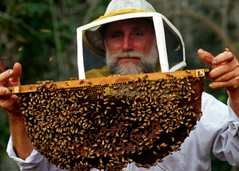Carbon Free Honey
Tropical Traders Specialty Foods, LLC, which produces the Royal Hawaiian Honey line, decided it could have a positive impact on climate change.
In 2007, Royal Hawaiian Honey, in partnership with Carbonfund.org, performed a product life-cycle carbon dioxide analysis, which determines a product’s carbon footprint. Royal Hawaiian Honey calculated how much energy is consumed in the production, shipping and distribution of all of the components that go into each and every jar of Royal Hawaiian Honey. This includes the extraction of silica from the ground to manufacture the glass jars, the production and printing of its label, the amount of energy used in bottling the honey, and the shipping of its products from Hawaii to markets as far away as New York. Once this figure was determined, the energy used is offset by investing in renewable energy sources, such as wind and solar.
By taking responsibility for its carbon footprint and neutralizing its emissions, the Royal Hawaiian Honey label is working within its industry to make a difference. Since 2007, the Royal Hawaiian Honey brand has offset 60.25 metric tons of carbon emissions through an investment in reforestation, energy efficiency and renewable energy projects.
What Actions Does Royal Hawaiian Honey Take to be Fully Organic?
In order for honey to be certified organic, the bees that make it must not forage on any flowers that are sprayed with herbicides or pesticides. In addition, the beekeeper cannot use any chemicals or antibiotics in the production of the honey. Their apiary is inspected by the Hawaii Organic Farmers Association. As a result, Royal Hawaiian Honeys are some of the only honeys produced in the entire U.S. that are certified organic.
What Actions Does Royal Hawaiian Honey Take to Stay Local?
Royal Hawaiian Honey’s packaging components (like the container, lid, and label) are made in the United States to cut-down on shipping, which in turn helps reduce their carbon footprint.
What Actions Does Royal Hawaiian Honey Take to Stay Carbon Neutral?
Royal Hawaiian Honey measures the carbon emissions generated in the harvesting, production, shipping and distribution of every one of the units of honey it sells. Their calculation also includes the emissions generated in the production of all of the packaging components used. Once measured, the carbon emissions are offset by investing in renewable energy projects, reforestation and energy efficiency projects made possible by the purchase of carbon off-sets.
What Actions Does Royal Hawaiian Honey Take to Produce Less Waste?
Typically, honey is shipped on pallets made of pine wood with a sheet of new cardboard between the product and the pallet. Instead of buying new cardboard, they re-use boxes by cutting them to the right size for the pallet, eliminating waste. They also work with a pallet exchange program, in which they rent pallets. When the pallets arrive at their destination, they get sent back to the company. This reduces waste, and saves trees from being milled for new pallets.
“We celebrate artisanal beekeeping through healthy, delicious and ethical products from the hive.” - Royal Hawaiian Honey


Royal Hawaiian Honeys are 100 percent raw, single-source varietal honeys harvested by a family-owned apiary on the Big Island of Hawaii. Royal Hawaiian adheres to strict standards of sustainability by practicing organic farming and implementing a carbon-free initiative.
Climate Actions
- Avoids chemicals or antibiotic use in their hives
- Hives are inspected by Hawaii Organic Farmers Association
- Uses packaging components made in the U.S.
- Measures and purchases offsets for all carbon emissions resulting from their business operations
- Re-use boxes and pallets to ship their honey
- Uses shipping products made from 100 percent biodegradable materials
Estimated Yearly Savings
Since 2007, the Royal Hawaiian Honey brand has offset 60.25 metric tons of carbon emissions through an investment in reforestation,energy efficiency and renewable energy projects.
